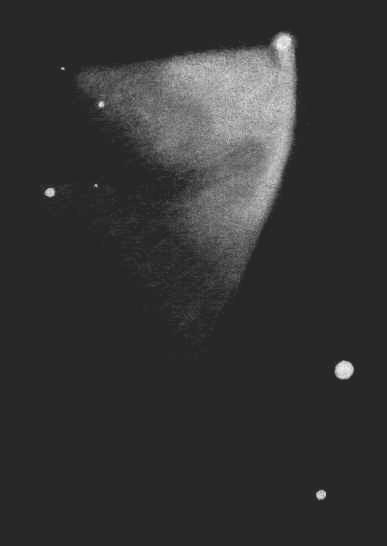
Observer: Mark G.Birkmann
Your skills: Intermediate (some years)
Date/time of observation: 11-4-99 9:00 UT (3:00 am CST)
Location of site: New Haven, Missouri (Lat ~38, Elev ~700')
Site classification: Rural
Sky darkness: 3/4 some high thin clouds <1-10 Scale (10 best)>
Seeing: 4 <1-10 Seeing Scale (10 best)>
Moon presence: None - moon not in sky
Instrument: 40" f/5 dob
Magnification: lowest power 125x
Filter(s): OIII, H-beta, Orion Ultrablock
Category: Reflection nebula.
Class: E + R e1
Constellation: Monoceros
Data: mag ? size 2' x 1'
Position: RA 06h:39m 12s DEC +08 :44' 00"
Description:
This nebula appeared to have 3 fairly distinct levels of brightness with the
brightest being near the embedded star at the tip. The star did not have a
stellar appearance but was embedded in nebulousity. Just behind the star is
a small slightly darker lane that is connected to the edge of the nebula and
goes about two thirds of the way across. At the back edge of this brightest
level nebulousity three features were seen. First, a concave area was noted
about one third of the way in from the edge. Adjacent to this was a large dark
lane that extended through the middle, dimmer level of nebulousity. An
extension of the brightest area of nebulousity went down the side about
half way into the middle area of nebulousity. The middle area of nebulousity
was fairly uniform in brightness and had a straight rear border that extended
to the large dark lane. The border continued on the other side of the dark
lane but was a little farther back. The next level of nebulousity was very
faint and was only seen on the same side of the nebula as the bright extension
into the middle area of nebulousity. I hope to view this nebula again in a
few months to look for changes.
